The Japanese have different ways of dealing with winter weather than we've experienced in America. It's common to see cars sitting with their windshield wipers standing out. People do this so that they won't freeze to the windshield, which totally makes sense if you've ever tried to prise frozen rubber away from glass. In Kitakami, street crews don't salt or sand the roads �� driving precautions are up to individuals. Almost everyone has snow tires or chains. Roads aren't graded down to the asphalt. As far as we can tell, they're not really graded at all, but harvested. Snow is clearly removed from them because the level on the roads is lower than that in yards and parking lots, but a layer is still there and there aren't piles of gray, dirty snow lining the streets. The result is that even two or three weeks after a big snowfall, the landscape is still quite beautiful, if the roads are a bit more dangerous than we're used to. It's not a bad trade-off.
The Japanese have different ways of dealing with winter weather than we've experienced in America. It's common to see cars sitting with their windshield wipers standing out. People do this so that they won't freeze to the windshield, which totally makes sense if you've ever tried to prise frozen rubber away from glass. In Kitakami, street crews don't salt or sand the roads �� driving precautions are up to individuals. Almost everyone has snow tires or chains. Roads aren't graded down to the asphalt. As far as we can tell, they're not really graded at all, but harvested. Snow is clearly removed from them because the level on the roads is lower than that in yards and parking lots, but a layer is still there and there aren't piles of gray, dirty snow lining the streets. The result is that even two or three weeks after a big snowfall, the landscape is still quite beautiful, if the roads are a bit more dangerous than we're used to. It's not a bad trade-off.
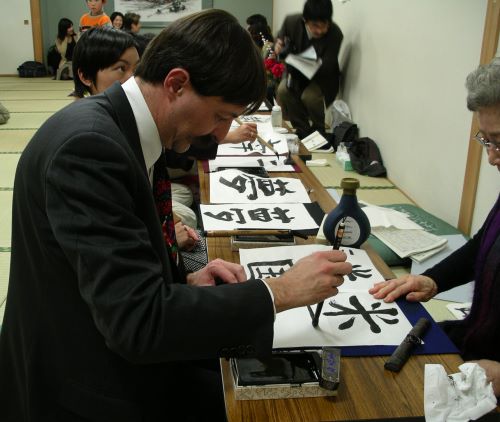
We also tried koto and shakuhachi, Japanese bamboo flute. Our trial was featured in a photo in the Sunday newspaper, which unfortunately is not available online.
Each group also put on a demonstration. The tea ceremony practitioners prepared the traditional New Year's tea, which contained a pickled plum and a tied bit of seaweed. The tea was served with youkan and black bean and walnut mochi.
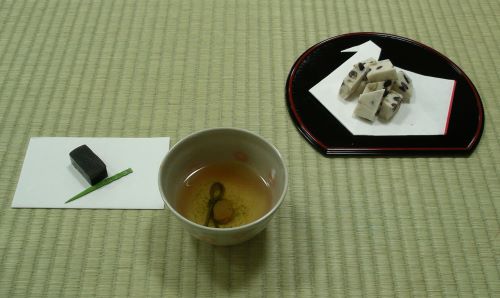
One of the more energetic groups performed a type of Japanese street entertainment. They chanted a folk tale while dancing with props resembling small bamboo fences that they could manipulate into different forms.
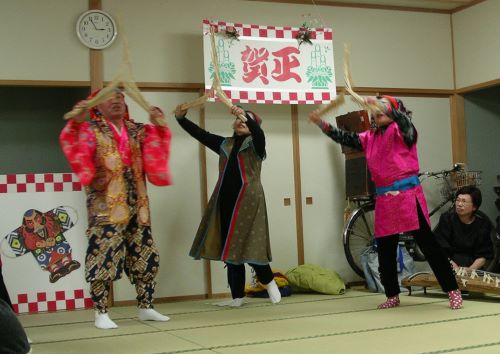
As we've mentioned before, mochi is one of the traditional Japanese New Year's foods. Mochitsuki is the traditional mochi-making ceremony, during which members of the community use large wooden mallets to pound polished, cooked rice into a sticky paste. Once the paste is made, it is formed into small cakes, which can then be eaten.
At the encouragement of our hosts, we took a turn kneading the mochi with the giant mallets.
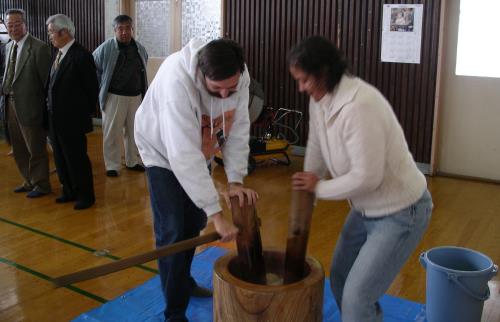
It was fun, but we clearly lacked the energy and expertise of the locals.
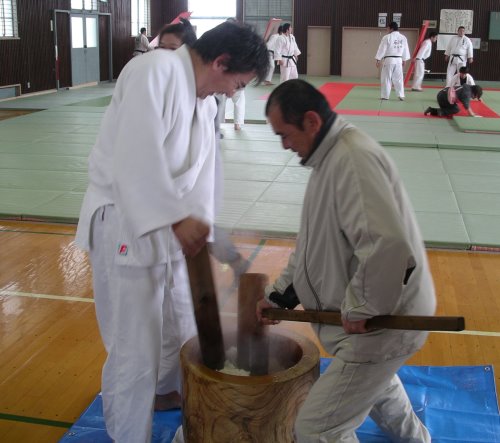
Once the kneading was completed, people alternated pounding the rice with a quick water rinse to keep it from sticking to the equipment. Children, assisted at times by their parents, got in on the pounding too. It was a great community event; one that we're glad we went out into the white-out conditions for.
In Japan, winter is the high season of the strawberry. Strawberries sit in little boxes in displays at the front of the store, announcing their provenance and price ("Fresh Strawberries from Sendai! 680 yen!"), drawing attention away from all the other fruits. Every patisserie sets out an array of strawberried treats �� filled, topped, stuffed with jam, you name it. Strawberry KitKats, strawberry danish, and strawberry eclairs are everywhere. Traditional sweets, like daifuku (anko-filled mochi balls) contain strawberries at this time of year, too.
The prominence of strawberries in January is very strange to me because, as for most Americans, strawberries scream "summer!" It seems somehow wrong to see them everywhere when we're still rocking our snowboots every day. A bit of research revealed that in many parts of Japan, strawberries alternate with rice as a part-of-the-year crop, so it's not completely out of the question that they would be reaching peak over the winter months. In fact, the strawberries we've eaten were grown in Japan and were quite delicious. On the other hand, it makes me think: perhaps the strawberry producers are in cahoots with the weathermen ("If we sell strawberries during the winter, they'll make people think of summer! They'll forget that the temperature hasn't gotten above freezing in six days, and all will be right as rain!).
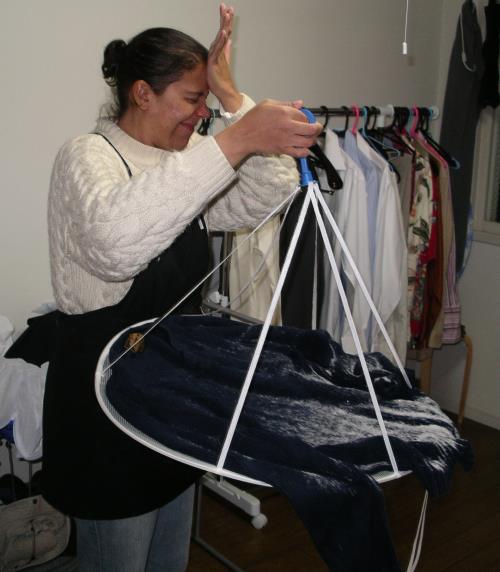
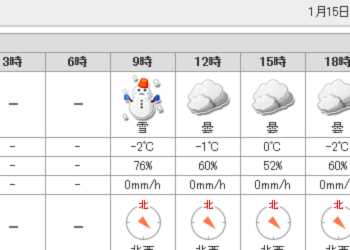
Now, let's take a look out the window:
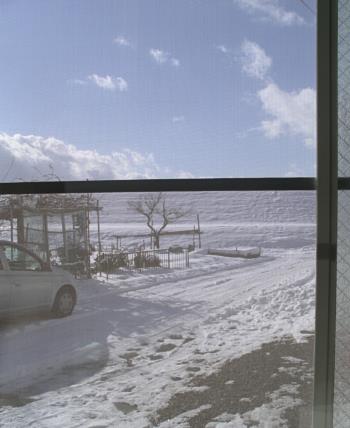
That's about how it goes with the weather forecasts here. They aren't just inaccurate, they're willfully dishonest, or at least it seems so. My theory is that the weathermen are part of a secret government program to emotionally control the people and prevent revolt. When it's nice out (or will be), the forecast shows nasty weather, so that everyone gets a pleasant surprise and is happy. When it's nasty out, the forecast shows nice weather tomorrow or the next day, which gives people hope (even though the nice weather doesn't actually arrive until three weeks later).
A quick dictionary consult, and we had found the Japanese name for horseradish: seiyou wasabi (���Τ蘆��) — literally, "Western wasabi".
For our dinner, we had a nimono (kinpira gobou, simmered burdock root), an aemono (shira-ae, tofu dressing on vegetables and konnyaku), and sashimi (katsuo tataki, seared bonito) with ponzu sauce. The tsukemono were pickled carrots from my nuka-zuke bed.
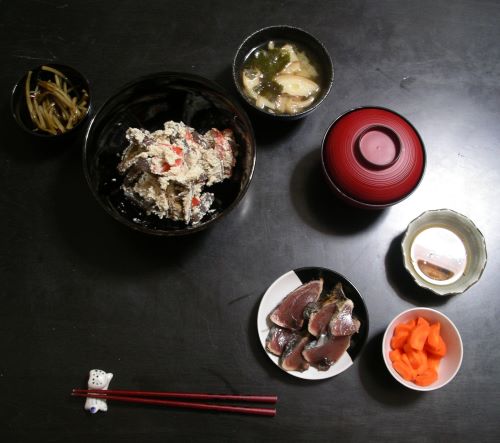
Making the dinner was pretty time-consuming, as was the cleanup. It was totally worth the effort.
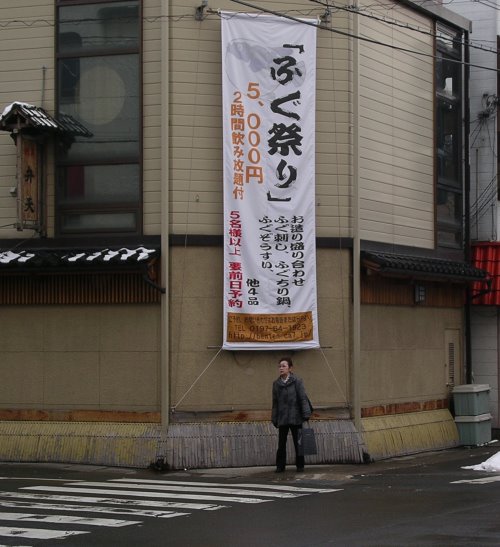
The festival appears to be featuring a sampler of fugu dishes, including fugu sashimi, fugu chirinabe (hotpot), and fugu zousui (rice porridge mixed with soup). There are four other unnamed dishes available as well. It's 5,000 yen for two hours of nomihoudai (all-you-can-drink) and the fugu sampler �� we're passing on this one.
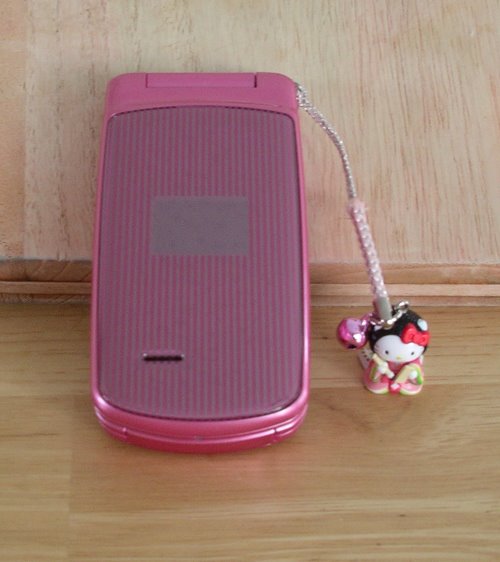
It's Hello Kitty, of course, but she's special. Sanrio makes Hello Kitty merchandise specific to each of the prefectures, representing events or products for which the prefecture is known. This Kitty-chan represents the famous Heian period poetess, Komachi, who according to legend was from what is now Akita Prefecture. Komachi was also regarded as a great beauty, which Matthew thinks makes her name particularly fitting for the Akita Shinkansen.
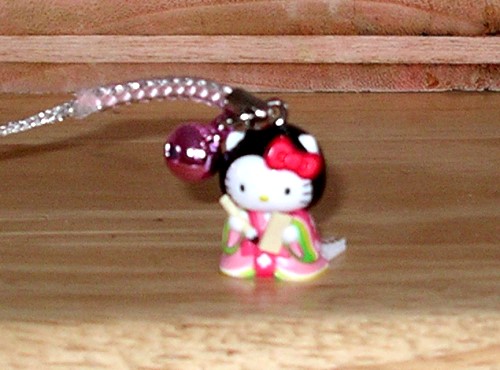
Back Next
 Calendar
Calendar




